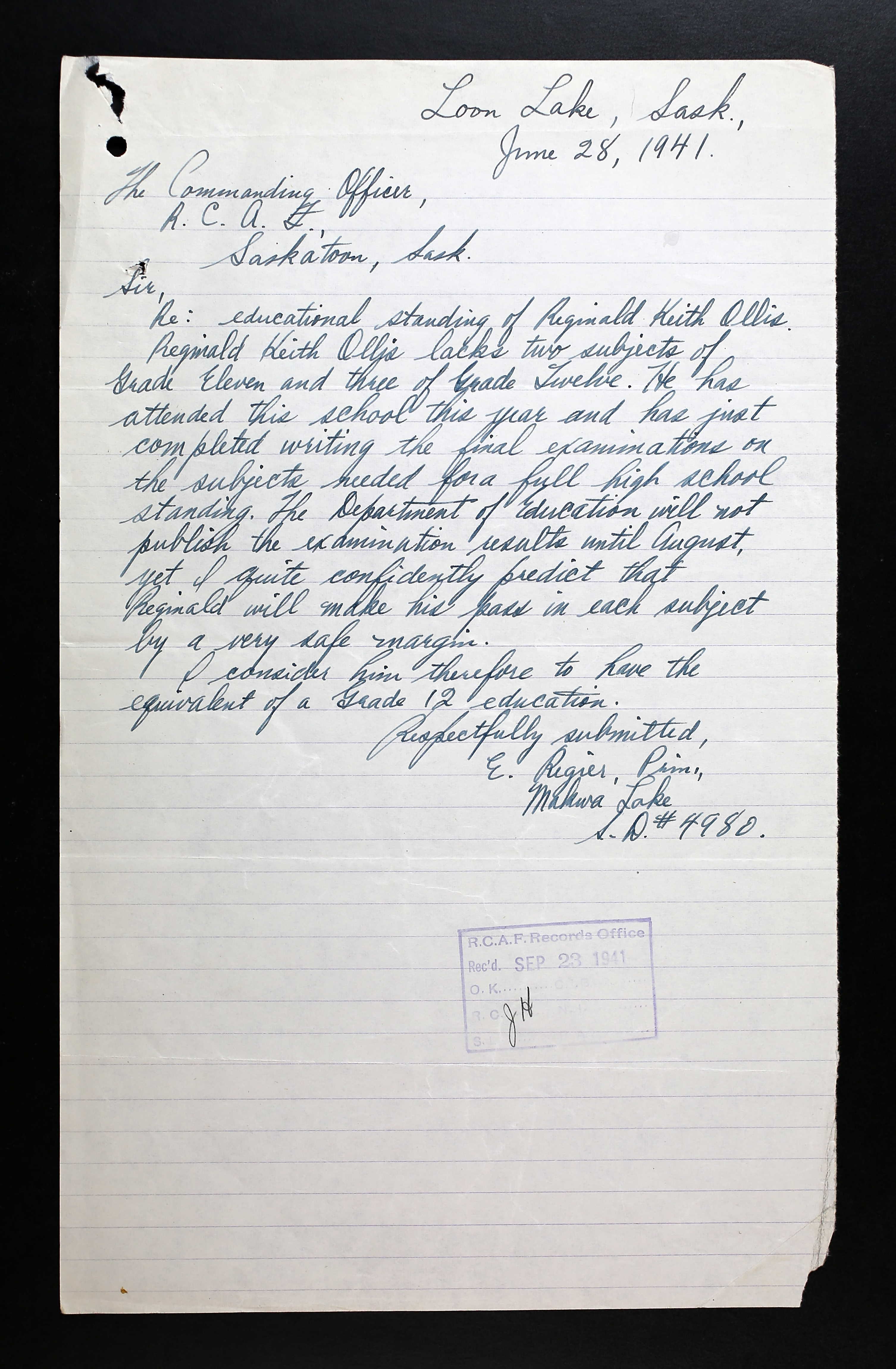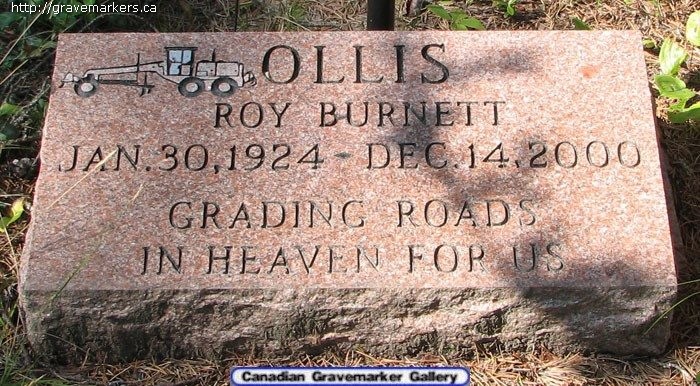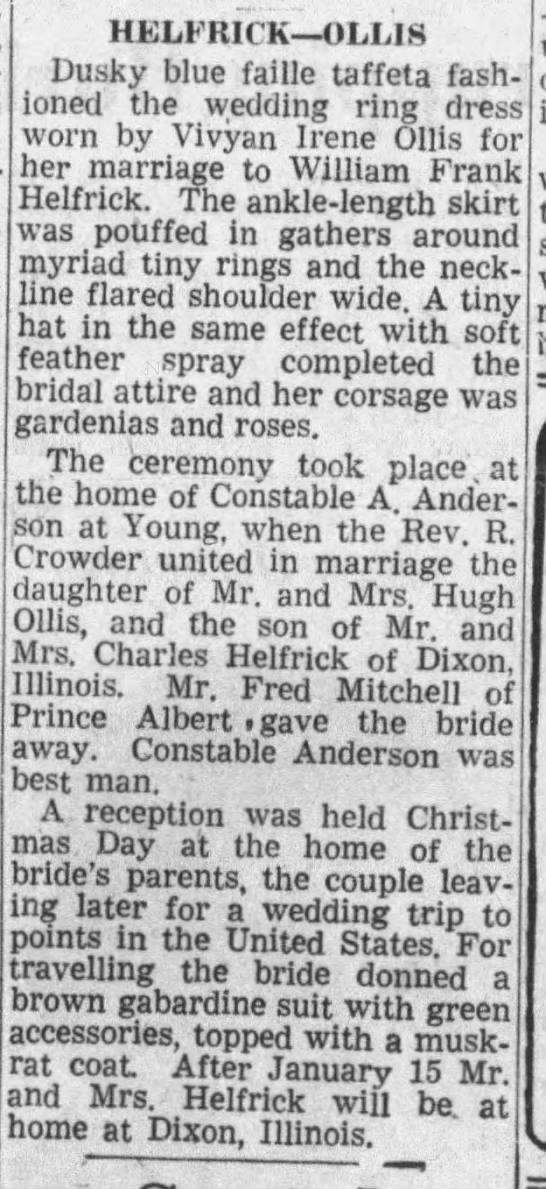



July 13, 1922 - April 22, 1943




Reginald Keith Ollis, born in Meadow Lake, Saskatchewan, was the son of Hugh Edward Ollis (1888-1975), farmer, and Emily Miller (nee McGregor) Ollis (1889 – 1972) of North Makwa, Saskatchewan, 180 km north of North Battleford. He had one sister, Vivyan Irene, plus four brothers, Edward Stanley (1914-1996), Lawrence Elford (1917-1945), Roy Burnette (1924-2000), and Gerald Tuplin (d. 1989). Edward and Lawrence joined the Canadian Army. Vivyan was studying to be a nurse at St. Paul’s Hospital in Saskatoon. The family was Anglican.
Prior to Reginald’s enlistment with the RCAF in Saskatoon in September 1941, he was a student, having achieved Grade XII. He had previous military experience (one month) with Prince Albert and Battleford Volunteers. Reginald hoped to return to university and study civil or electrical engineering. “Young man, good farm type with satisfactory educational qualifications. Well built, neat, polite, anxious to serve RCAF. Should make good aircrew material.”
He enjoyed hocky, moderately, but baseball extensively. Reading and electrical appliances were his hobbies. He smoked ‘moderately’ and did not indicate alcohol consumption. Reginald noted he had pleurisy in 1935, leaving him with a scar on his right side of his chest, plus had the measles. He had a white patch on upper front right thigh (vitiligo). He stood 5’10” and weighed 146 pounds. He had blue eyes and light hair, with a fair complexion. “Desirable type of applicant. Physically fit. Suitable for pilot only. (visual acuity.)”
On October 16, 1941, while at No. 2 Manning Depot, Brandon, Manitoba, Reginald wrote out his will, making his father his sole beneficiary. He also had a life insurance policy through Confederation Life, his mother the beneficiary.
Reginald was then sent to No. 13 SFTS, St. Hubert, QC for two months until there was space for him to start his training through the BCATP.
Reginald was sent to No. 1 ITS, Victoriaville, QC, Course 49, from March 16 to May 8, 1942. He was 107th out of 185 in class, with a 76%. “Determined, dependable, intelligent, serious. Alternative: Wireless Air Gunner.” On March 3, 1926, on his medical exam, his hands were noted as cyanotic: blue discolouration of the skin due to not enough oxygen in the blood. He was considered fit, but there was some cardio vascular instability. “Motivation: average. Wants pilot, ground crew. Intelligence: average. Emotional stability: average. General adjustment: fairly well adjusted. Comments: not impressive aircrew.” F/L R. T. Gates.
Then he was at No. 5 Manning Depot, Lachine, QC for two weeks before being sent to No. 11 EFTS, Cap-de-la-Madeleine, QC, Course 57, from June 8 to August 2, 1942. He was 12th in a class of 29, with a 70.4%. “Average service material. Learns quite easily. Conscientious, and dependable. No outstanding faults. Good average student, reliable, sincere, quiet, attentive in class, conduct good.”
From August 3 to November 20, 1942, he was in Course 61 at No. 5 SFTS, Brantford, Ontario, he scored 65.7% and was 31st out of 49 in his class. “A poor average pilot both clear hood and in instruments, and extremely weak in navigation. He managed to obtain a fair average in ground school. His efforts are not in any way assisted by his general attitude. On the recommendation of No. 1 Visiting Flight, this pupil’s flying training has been discontinued.”
Reginald was sent to Trenton, Ontario to KTS (Composite Training School) from November 17 until December 4, 1942, after which the RCAF sent Reginald to No. 7 Bombing and Gunnery School in Paulson, Manitoba until February 6, 1943. He was given additional training at No. 7 Air Observer School in Portage la Prairie. He received his Air Bomber’s Badge and commission on March 19, 1943.
By April 4, 1943, Reginald was at Y Depot, Halifax, and awaiting transport overseas.
Sometime later, he, with 36 other RCAF airmen, boarded the Amerika. On April 22, while on its way from Halifax, Nova Scotia to Liverpool, it was torpedoed as the ship was heading to Britain. It was a straggler in convoy HX-234. Thirty-seven men, all officers in the RCAF, were presumed missing as a result of enemy action at sea including Reginald. Their ship was sunk by U-306, south of Cape Farewell, off Greenland.
Forty-two crew members and seven gunners were also amongst those who were lost. The master, Christian Nielsen, 29 crewmembers, eight gunners, and sixteen passengers (RCAF airmen) were picked up by the HMS Asphodel, and landed at Greenock. General cargo, including metal, flour, meat and 200 bags of mail were also lost.
Mr. and Mrs. Ollis received a letter dated June 25, 1943 from F/L W. R. Gunn, RCAF Casualties Officer for Chief of the Air Staff. "Since my letter of May 6th, no additional news has been received. Attached is a list of the names and next-of-kin of sixteen Royal Canadian Air Force officers who embarked on the same ship as your son and following enemy action at sea were safely landed in the United Kingdom. The following official statement was made in the House of Commons....’I have been in receipt of communications from a number of members of this house and from people outside with reference to rumours regarding the recent loss of a number of members of the RCAF by the sinking of a ship in the north Atlantic and I desire to make the following statement on the facts. The vessel in question was a ship of British registry of 8,862 tons, designed for peace-time carriage of both passengers and freight, and having a speed of fifteen knots. She carried a crew of 86 and the passenger accommodation consisted of 12 two-berth rooms with bath and 29 other berths, providing cabin accommodations for 53 passengers. She was fitted with lifeboat capacity for 231 and travelled in naval convoy. Under the recently revised regulations agreed to by the United States authorities, the joint United Kingdom and United States shipping board, the Admiralty, the Air Ministry and the Canadian authorities, a vessel of this description travelling in convoy is permitted to embark as crew and passengers a maximum of 75% of the lifeboat capacity. The lifeboat capacity as stated above was 231, 75% of which is 173. Personnel on board consisted of the crew of 86, and RCAF personnel numbering 53, a total of 139, well within the prescribed limits. Because of the superior type of available passenger accommodation, the speed of the ship and the provision of naval convoy, the offer of the entire available space to the RCAF was immediately accepted. Rumours to the effect that this was a slow freighter not suitable for passenger accommodation are, of course, not in accord with the facts. Every precaution was taken to safeguard the lives of these gallant young men. It should be pointed out that on account of the serious shipping shortage every available berth on such ships must be used, and had the space not been taken up by the RCAF officers of the other arms of the services would have been placed on board. It should also be stated again that the submarine is still the enemy’s most powerful weapon and that the Battle of the Atlantic is not yet won. Any ocean trip today in any part of the world is fraught with danger and I think I may safely say that our record in transporting our soldiers and airmen to the United Kingdom is one of while we may all be proud. No one deplores more than I do the loss of 37 of the finest of our young men who gave their lives for their country as surely as if they had done so in actual combat with the enemy, and I extend my deepest sympathy to their loved ones in their bereavement.’ If further information becomes available, you are to be reassured it will be communicated to you at once. May I again extend to you my sincere sympathy in this time of great anxiety."
In early January 1944, Reginald’s mother received another letter from S/L W. R. Gunn that Reginald would now be presumed dead for official purposes.
In March 1945, Mr. and Mrs. Ollis received a telegram telling them that their son, Lawrence, was killed while serving with the Royal Canadian Artillery in Germany.
Vivyan graduated from nursing in May 1946 and married William Frank Helfrick in 1950.
In October 1955, a letter addressed to Mrs. Ollis from W/C W. R. Gunn arrived, informing her that Reginald’s name would appear on the Ottawa Memorial, as Reginald had no known grave, expressing sympathy on the loss of her gallant son.